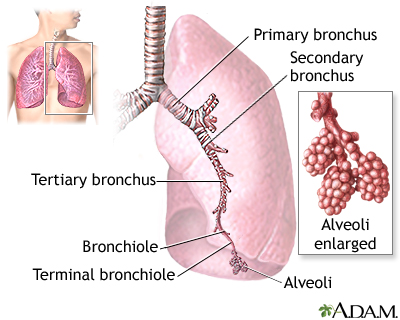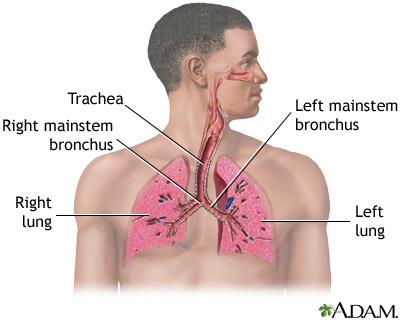Health Library
Bronchiectasis
Acquired bronchiectasis; Congenital bronchiectasis; Chronic lung disease - bronchiectasis
Bronchiectasis is a disease in which the large airways in the lungs are damaged. This causes the airways to become permanently wider.
Bronchiectasis can be present at birth or infancy or develop later in life.
Images


I Would Like to Learn About:
Causes
Bronchiectasis is often caused by inflammation or infection of the airways that keeps coming back.
Sometimes it begins in childhood after having a severe lung infection or inhaling a foreign object. Breathing in food particles can also lead to this condition.
Other causes of bronchiectasis can include:
- Cystic fibrosis, a disease that causes thick, sticky mucus to build up in the lungs
- Autoimmune disorders, such as rheumatoid arthritis, Sjögren syndrome or inflammatory bowel disease
- Allergic lung diseases
- Leukemia and related cancers
- Immune deficiency syndromes
- Primary ciliary dyskinesia (another congenital disease)
- Infection with non-tuberculous mycobacteria
- As a complication of bronchiolitis obliterans
- Asthma or chronic obstructive lung disease (uncommon)
Symptoms
Symptoms develop over time. They may occur months or years after the event that causes the bronchiectasis.
Long-term (chronic) cough with large amounts of foul smelling sputum is the main symptom of bronchiectasis. Other symptoms may include:
- Breath odor
- Coughing up blood (less common in children)
- Fatigue
- Paleness
- Shortness of breath that gets worse with exercise
- Weight loss
- Wheezing
- Low grade fever and night sweats
- Clubbing of fingers (rare, depends on cause)
Exams and Tests
The health care provider will perform a physical exam. When listening to the chest with a stethoscope, the provider may hear small clicking, bubbling, wheezing, rattling, or other sounds, usually in the lower lungs.
Tests that may be done include:
- Aspergillosis precipitin test (to check for signs of an allergic reaction to fungus)
- Alpha-1 antitrypsin blood test
- Chest x-ray
- Chest CT
- Sputum culture
- Complete blood count (CBC)
- Genetic testing, including sweat test for cystic fibrosis and tests for other diseases (like primary ciliary dyskinesia)
- PPD skin test to check for a past tuberculosis infection
- Serum immunoglobulin electrophoresis to measure proteins called immunoglobulins in the blood
- Lung function tests to measure breathing and how well the lungs are functioning
- Immune deficiency workup
Treatment
Treatment is aimed at:
- Controlling infections and sputum
- Relieving airway blockage
- Preventing the problem from becoming worse
- Treating the underlying cause (for example modulator therapy for people with cystic fibrosis)
Daily drainage to remove sputum is part of treatment. A respiratory therapist can show the person coughing exercises that will help.
Medicines are often prescribed. These include:
- Antibiotics to treat infections
- Bronchodilators to open up airways
- Expectorants to help loosen and cough up thick sputum
Surgery to remove (resect) the lung may be needed if medicine does not work and the disease is in a small area, or if the person has a lot of bleeding in the lungs. It is more commonly considered if there is no genetic or acquired predisposition to bronchiectasis (for example, more likely to consider if there is bronchiectasis in one segment of the lung only because of prior obstruction).
In severe cases, lung transplantation might be needed.
Outlook (Prognosis)
The outlook depends on the specific cause of the disease. With treatment, most people live without major disability and the disease progresses slowly.
Possible Complications
Complications of bronchiectasis may include:
- Cor pulmonale
- Coughing up blood
- Low oxygen levels (in severe cases)
- Recurrent pneumonia
- Depression
When to Contact a Medical Professional
Contact your provider if:
- Chest pain or shortness of breath gets worse
- There is a change in the color or amount of phlegm you cough up, or if it is bloody
- Other symptoms get worse or do not improve with treatment
Prevention
You can reduce your risk by promptly treating lung infections.
Childhood vaccines a yearly flu vaccine, and COVID-19 vaccines help reduce the chance of some infections. Avoiding upper respiratory infections, smoking, and pollution may also reduce your risk of getting this infection.
Related Information
Foreign object - swallowedCystic fibrosis
Cor pulmonale
Community-acquired pneumonia in adults
Lung surgery - discharge
References
Chang AB, Redding GJ. Bronchiectasis and chronic suppurative lung disease. In: Wilmott RW, Deterding R, Li A, et al, eds. Kendig's Disorders of the Respiratory Tract in Children. 9th ed. Philadelphia, PA: Elsevier; 2019:chap 26.
O'Donnell AE. Bronchiectasis, atelectasis, cysts, and localized lung disorders. In: Goldman L, Schafer AI, eds. Goldman-Cecil Medicine. 26th ed. Philadelphia, PA: Elsevier; 2020:chap 84.
Solomon GM, Chan ED. Bronchiectasis. In: Broaddus VC, Ernst JD, King TE, et al, eds. Murray and Nadel's Textbook of Respiratory Medicine. 7th ed. Philadelphia, PA: Elsevier; 2022:chap 69.
BACK TO TOPReview Date: 7/31/2022
Reviewed By: Denis Hadjiliadis, MD, MHS, Paul F. Harron, Jr. Professor of Medicine, Pulmonary, Allergy, and Critical Care, Perelman School of Medicine, University of Pennsylvania, Philadelphia, PA. Also reviewed by David C. Dugdale, MD, Medical Director, Brenda Conaway, Editorial Director, and the A.D.A.M. Editorial team.
 | A.D.A.M., Inc. is accredited by URAC, for Health Content Provider (www.urac.org). URAC's accreditation program is an independent audit to verify that A.D.A.M. follows rigorous standards of quality and accountability. A.D.A.M. is among the first to achieve this important distinction for online health information and services. Learn more about A.D.A.M.'s editorial policy, editorial process and privacy policy. A.D.A.M. is also a founding member of Hi-Ethics. This site complies with the HONcode standard for trustworthy health information: verify here. |
The information provided herein should not be used during any medical emergency or for the diagnosis or treatment of any medical condition. A licensed medical professional should be consulted for diagnosis and treatment of any and all medical conditions. Links to other sites are provided for information only -- they do not constitute endorsements of those other sites. © 1997- 2023 A.D.A.M., a business unit of Ebix, Inc. Any duplication or distribution of the information contained herein is strictly prohibited.
